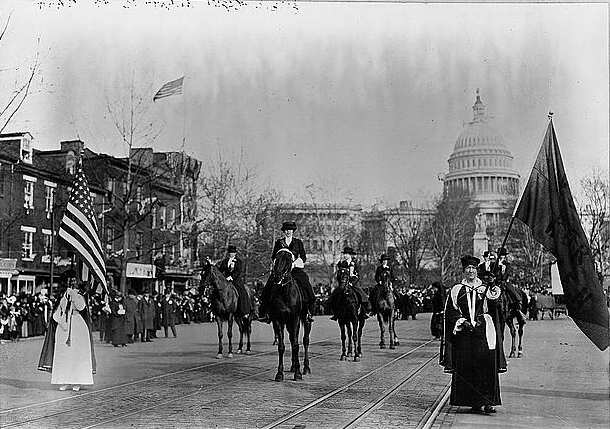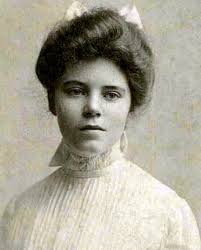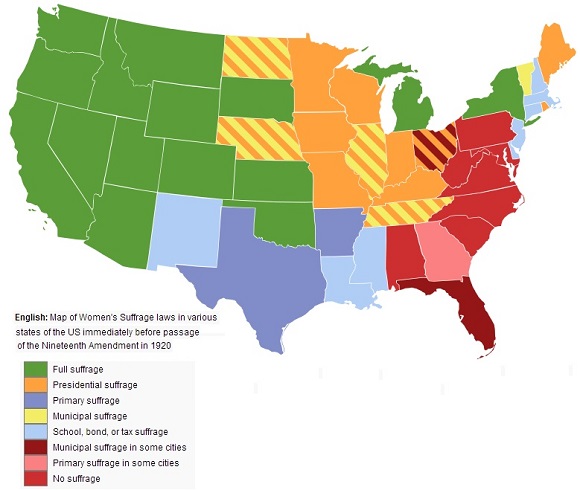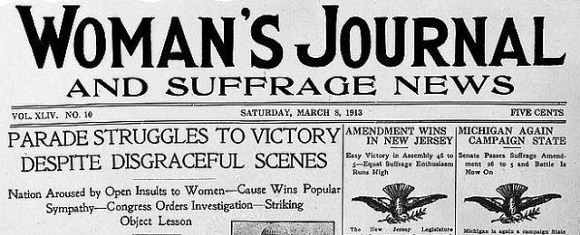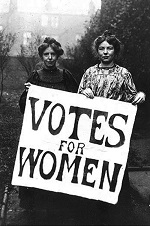
It is hard to imagine that in the United States, the land of opportunity for all, that not so long ago half of our population could not exercise the right to vote. On Election Day in 1920 women finally could go to the polls and cast their ballots. To get there, it took nearly 100 years and the contributions of many great women. Alice Paul of the National Women's Party will be remembered for her relentless push to gain the support of President Woodrow Wilson and ultimately both houses of Congress to pass the 19th Amendment.
America won its freedom from Britain and was born on the strength of its documents, the Declaration of Independence and the Constitution. The 2nd paragraph of the Declaration of Independence states:
We hold these truths to be self-evident, that all men are created equal, that they are endowed by their Creator with certain unalienable Rights, that among these are Life, Liberty and the pursuit of Happiness.
In stating that all men are created equal, the document explicitly brushes off half of the population. Rather than saying "all people are created equal" or "all men and women are created equal" our defining document establishes a 2nd class for those who are born female. This fits with the times, as a woman of the 18th and 19th century was expected to be a devoted wife to her husband, a mother of her children, and attend to matters of the home and family.
On July 19 and 20, 1848 in Seneca Falls, New York, over 300 people gathered for the first ever convention on women's rights. The convention, organized by Elizabeth Cady Stanton and Lucretia Mott, was attended by mostly women but some men, and produced a document called the Declaration of Sentiments, which became the guiding document for the women's suffrage movement going forward. In it, they declared that "all men and women are created equal" and that women should have the right to vote. History would prove this to be a mighty difficult task, but new generations of woman activists would carry it forward.
The abolitionist movement and Civil War consumed America, and in the aftermath the 14th and 15th amendments to the Constitution were passed, guaranteeing the rights of all black citizens to vote, as long as they were male. Stanton and other woman activists including Susan B. Anthony, refused to support the rights of blacks to vote as long as women were denied the same right. Anthony and Stanton formed the American Equal Rights Association in 1866 that would fight tirelessly for an amendment to the Constitution allowing women the right to vote. In 1869, the women's suffrage movement split, with Anthony and Stanton's organization committed to a Constitutional Amendment, while a second group chose to obtain the vote on a state-by-state basis. In 1872 Anthony and a number of woman activists were arrested for actually - voting. Anthony and Stanton's organization continued to push Congress for a constitutional amendment, with Anthony appearing before Congress every year from 1869 to 1906. The all-male Congress refused to take the women's suffrage movement seriously, and Susan B. Anthony died in 1906 before she could see the fruits of her struggle.
By the turn of the 20th century, the national women's movement had merged back together to form the National American Women's Suffrage Association (NAWSA) which was led by Carrie Chapman Catt. Catt was a practical leader who favored the state-by-state approach that would eventually bring Congress to favor national women's suffrage. A young and energetic leader Alice Paul emerged as part of the national women's movement, and in 1912 Paul was appointed to head the NAWSA Congressional Committee in Washington. Paul's approach was much more direct and confrontational. Paul's group had little funding, but they organized a parade on Pennsylvania Avenue on the day of new President Woodrow Wilson's inaugural address. The parade made headlines as male onlookers attacked the women, first with insults and then with physical violence as police looked on and did nothing.
Alice Paul and Carrie Chapman Catt shared the same goal - they wanted to see women gain the right to vote - but it was clear they would not work together as their strategies conflicted. Catt believed in the slow and methodical state-by-state approach, and to not push the President too far for fear of alienating him and losing him as an ally. Paul believed the most aggressive strategy at the national level was the only way to reach the goal of a Constitutional Amendment. Alice Paul's group completely split off from NAWSA in 1916 to form the National Women's Party. When they brought their goals to President Wilson, Wilson expressed sympathy for women but refused to put women's suffrage as a policy priority for his Presidency. The National Women's Party continued their marches in front of the White House, publically criticizing Wilson.
The US declared war in 1917, sending thousands of soldiers off the Europe while men and women at home rallied around supporting the war effort. Paul and the suffragettes continued their protests and were met with angry mobs who considered them unpatriotic to be protesting against a President during wartime. The women argued that how could we fight for democracy abroad when we did not have a true democracy at home. Paul and many of the suffragettes were then arrested on charges of obstructing traffic (?) and were sent to a prison in Virginia called the Occoquan Workhouse. Conditions in the prison were awful, and prison officials tried to make an example out of Alice Paul by placing her in solitary confinement. When she staged a hunger strike, they forcible fed her through a very painful process of placing a tube down her nose and throat and pouring liquid through the tube. In a final attempt to discredit Paul, they brought her to a mental hospital and tried to declare her insane. This could not have been President Wilson's intention in dealing with the suffragettes who he was supposedly allied with. When word got out of the treatment of the women in Occoquan, there was a public outcry which eventually forced Wilson''s hand to stop delaying and do the right thing.
Alice Paul and the rest of the imprisoned women were released from jail. On September 30, 1918 President Wilson made a speech before a joint session of Congress supporting a constitutional amendment guaranteeing a woman's right to vote. This line was part of Wilson's speech:
We have made partners of the women in this war. ... Shall we admit them only to a partnership of suffering and sacrifice and toil and not to a partnership of privilege and right?
Carrie Chapman Catt and the NAWSA came on board to support the amendment as well, as this is what her organization had been waiting for. It took a number of votes in the House and Senate to finally pass with the necessary 2/3 majority. On June 4, 1919 the Senate passed the amendment 56-25. It then went on to the states for ratification, and on August 24, 1920 Tennessee became the 36th state to ratify the amendment, making it officially part of our Constitution. The Tennessee vote was not without some drama - 24 year old legislator Harry Burn changed his vote in favor of the amendment after being urged to do so by a letter from his mother. Anti-suffragists were so angry with Burns that they chased him from the chamber and forced him to go into hiding for a time.
Passage of the 19th amendment gave women the vote but did not solve all of their problems, just as abolishing slavery did not solve racism. Alice Paul and many others continued their work in support of the Equal Rights Amendment and supporting women's rights at home and internationally. While women's equality has made great strides, women still lag behind men in workplace compensation and promotion opportunities. There will continue to be women pushing for their rights in the spirit of the suffragists that came before them.


